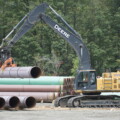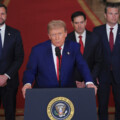Welcome to Need to Know, The Hub’s roundup of experts and insiders providing insights into the federal election stories, policy announcements, and campaign developments Canadians need to be keeping an eye on.
No candidate is offering a substantial change of direction on foreign policy or defence
By Richard Shimooka, a Hub contributing writer and a senior fellow at the Macdonald-Laurier Institute
For an election frequently billed as being one where foreign policy finally matters to Canadians, there’s actually been relatively little of substance when it comes to foreign and defence policy.
Certainly, there have been rhetoric and platitudes made by all candidates concerning Donald Trump and the bilateral relationship with the US. Mark Carney has stated that the close relationship between the two countries is over. One would assume that for such a potentially traumatic shift in Canadian foreign policy, he would have laid out a comprehensive plan or hard policies for dealing with the challenge. Yet nothing comes even close to addressing the potential challenge.
Perhaps that is the vicissitudes of having an election with the ongoing crisis, but other countries have made these dramatic shifts. Defence spending featured significantly in the recent German elections, and the past several months have seen dramatic increases in non-US allies’ spending to the point where the NATO spending floor may rise to 3 percent of GDP or higher.
Yet on defence policy, neither the Conservatives nor the Liberals are offering anything that’s substantially different from what came before. They’re essentially following the contours of the existing Our North Strong and Free policy published last year that prioritizes North American capabilities over European or Asian requirements.
Arguably, Pollievre’s shortsighted promise to cut foreign aid spending and devote it to defence is the only substantial departure from the current orthodoxy—and that more suggests greater retrenchment to domestic concerns than any renewed focus on foreign ones.
Overall, it’s shaping up to be a very ordinary Canadian election in foreign policy, with grand statements that bear little resemblance to major ongoing issues and little in the way of actual substance on this file.
The Liberals outpace the Conservatives on social media spending while the NDP barely make a dent
By Cole Hogan, a conservative strategist
From March 30 to April 5, the second full week of the campaign, Pierre Poilievre’s Conservatives spent $565,000 on Meta platforms. This represents a decrease of $133,000 from the previous week’s $698,000 spend. That $698,000 Conservative spend remains the largest weekly amount I’ve recorded since I began reporting on federal party ad spends last summer. Last week, Mark Carney’s Liberals were $1,000 short of matching that spend.
Mark Carney’s Liberals spent $697,000 on Meta platforms from March 30 to April 5, outpacing the Conservative ad spend of $565,000. The $697,000 spend by the Liberals represents a weekly increase of $15,000 from March 23 to March 29, when Liberals spent $682,000. This is a small increase in weekly spend, but given the decrease of $133,000 in the Conservative spend, it demonstrates the Liberals have outspent the Conservatives in the second week of the campaign.
This is the third week that Conservatives have spent over $560,000 on Meta platforms. It’s the second week Liberals have spent more than $680,000 on Meta platforms. This competitive, over half a million weekly ad spend will likely continue throughout the election for both the Liberals and the Conservatives.
The most viewed Conservative advertisement is currently a Pierre Poilievre Canada First rally ad in which he states, “Let me be clear. We will never be the 51st state. We will bear any burden and pay any price to protect the sovereignty and independence of our country.” The most viewed Liberal advertisement is currently one with Mark Carney sitting at a kitchen table, speaking into the camera and stating, “We’ll build a Canada you can afford.”
Jagmeet Singh’s NDP ad spend dropped from the week previous. The NDP spent $13,000 from March 23 to March 29 and $8,000 from March 30 to April 5, representing a decrease of $5,000 in their weekly ad spend. The NDP’s ad creative continues to be generic in design, mainly focusing on health care. There are now additional ads promoting NDP candidates in Nunavut and select ridings in British Columbia. There are no longer any active ads featuring Jagmeet Singh.
Emotions, crowds, and the misreading of public opinion
By Spencer Fernando, a Canadian writer and political commentator
Considering recent polls suggesting a Liberal lead, some have pointed to the large crowds at Conservative rallies as a more “authentic” measure of public sentiment.
While emotionally powerful, this perspective reflects a cognitive bias rather than an empirical truth.
We tend to view tangible events—particularly large gatherings—as evidence of social proof (the idea that widespread visible support implies broad consensus). We still possess elements of an ancestral mindset in which such gatherings were our primary indicator of collective opinion.
But in a country of over 40 million people (a figure so vast we can only grasp it in the abstract), public opinion cannot be accurately discerned by thousands gathering in one location.
That doesn’t mean such large rallies are meaningless, as they demonstrate a sophisticated organization and political message that motivates core supporters. Yet, while no method is flawless, scientifically conducted polls (particularly when multiple credible firms show similar results) remain the most reliable barometer of public opinion across a broad population—aside from election day of course.
This is important to keep in mind, both to ensure against future bad actors who may seek to cast doubt on the results of the election (whichever way it ultimately goes), and to ensure we remain anchored in reality rather than being swayed by emotionally satisfying, but misleading, impressions.









